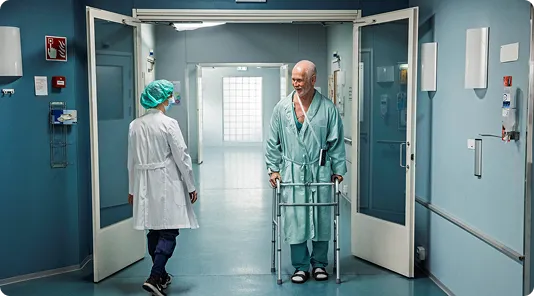The high cost of telemetry overuse — and how continuous vital signs monitoring can help ease the burden and burnout

Implementing wireless and wearable continuous vital signs monitoring for non-cardiac patients may help health systems and hospitals optimize patient care, reduce clinician burnout, and drive economic advantages.
01. How common is overuse of telemetry monitoring?
- #9 among the top health technology hazards: Overuse of cardiac telemetry can cause clinician cognitive overload and missed critical events. [1]
- 75% of physicians are comfortable with the idea of discontinuing telemetry monitoring based on American Heart Association (AHA) guidelines. [2]
Paradoxically, increased use of cardiac telemetry monitoring (for patients who do not require it) can lead to patients overall being less effectively monitored.
ECRI [4]
02. Conditions for which non-cardiac patients might be monitored in telemetry beds
- COPD exacerbation, pneumonia, pulmonary embolism, sepsis and blood hemorrhaging.[5]
- Gastrointestinal bleeding, renal failure.[6]
- End-stage renal disease, low-risk chest pain, syncope from non-cardiac causes.[7]
03. Problems telemetry overuse is creating
- Higher costs, diminished patient throughput, and increased length of stay.[8]
- Unnecessary alarms for already-overburdened clinicians [9] who are prone to alarm fatigue,[10] which can lead to medical errors, increase burnout, and interfere with patient recovery.[11]
Persistent and probing questions about telemetry
-
Is telemetry as helpful as previously thought? [12]
-
Is telemetry overuse impeding cost-effective patient care? [13]
04. Benefits of implementing continuous vital signs monitoring
While solutions to telemetry overuse include educating caregivers about AHA guidelines, [14] and building order sets and reminders into EHRs, [15] these have not focused on improving surveillance for non-cardiac patients who would benefit from continuous monitoring of vital signs, including:
-
Respiratory rate
-
Pulse rate
-
SpO2
Improving the patient experience
- Respiratory rate is a good indicator of impending decompensation but is often neglected as a vital sign. [16]
- Now, wireless and wearable sensors can accurately track respiratory rate with high sensitivity for early-stage detection of deterioration. [17]
- Pulse oximetry is also effective because a single sensor can provide timely indication of changes in patient state and is well-tolerated by patients. [18]
06. Driving economic advantages
In addition to improving the patient experience and reducing clinician burden, minimizing unnecessary use of telemetry has been shown to drive cost-savings:
-
$37,995.84 Per Monththe amount telemetry monitoring for non-AHA guideline patients cost an urban, tertiary care teaching hospital. [22]
-
$4.8 million Annuallythe savings a health system achieved by reducing the mean daily number of patients monitored with telemetry by 70%. [23]